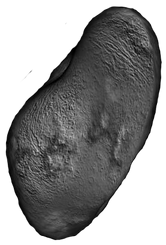Tag: Visual edit |
Tag: Visual edit |
||
| Line 18: | Line 18: | ||
==Formation== |
==Formation== |
||
| + | dggga |
||
| − | Himalia was a[[Asteroid belt#Composition| C-type asteroid]] that was being pulled in to Jupiter's orbit by its gravitational pull. After being pulled in to orbit, it suffered numerous collisions and debris from Himalia became the satellites of the Himalia group. Himalia is the largest of the group, which is the reason for the group being named after this moon. |
||
==Naming== |
==Naming== |
||
Revision as of 06:48, 16 July 2018
| Himalia | |
|---|---|
 | |
|
Planet of Origin |
Jupiter |
|
Discoverer |
Charles Dillon Perrine |
|
Date of Discovery |
December 3, 1904 |
|
Place of Discovery |
Lick Observatory |
|
Surface Color |
Mustard yellow |
|
Composition |
Porous ocean |
Himalia is the largest of the irregular-shaped satellites belonging to the planet of Jupiter. Being a prograde satellite, it was discovered on December 3, 1904 by Charles Dillon Perrine at the Lick Observatory. Due to its size and its brightness, Himalia is the easiest observed satellite of Jupiter. In fact, it is so large and massive, the only things larger are the Galilean moons. Although it is bright in apparent magnitude, Amalthea is brighter, yet further away and smaller, therefore being less easily observed by the human eye.
Formation
dggga
Naming
Himalia was named after Himalia, the nymph that bore three sons from Zeus. In the 1950's and 1970's, people mistook the name Himalia for Hestia, a Greek goddess.
Composition
Like many other moons belonging to Jupiter, water is thought to be present inside of the layers of Himalia, sandwiched between two layers.
Surface
The surface of Himalia appears to be gray and has other spectra of color that match that of a C-type asteroid. There are no visible mountainous areas or valleys, common in Himalia grouped satellites. The only visible mountainous areas are under the surface in the lower crust. It is believed that these mountains will soon be pushed to the surface in the next million years.
Exploration
In 2000, Himalia was photographed by the Cassini spacecraft. Only though the images were a few pixels in length and height, the images can show the axes of the moon match that of Earth-based measurements. The image was taken from five million miles away.
